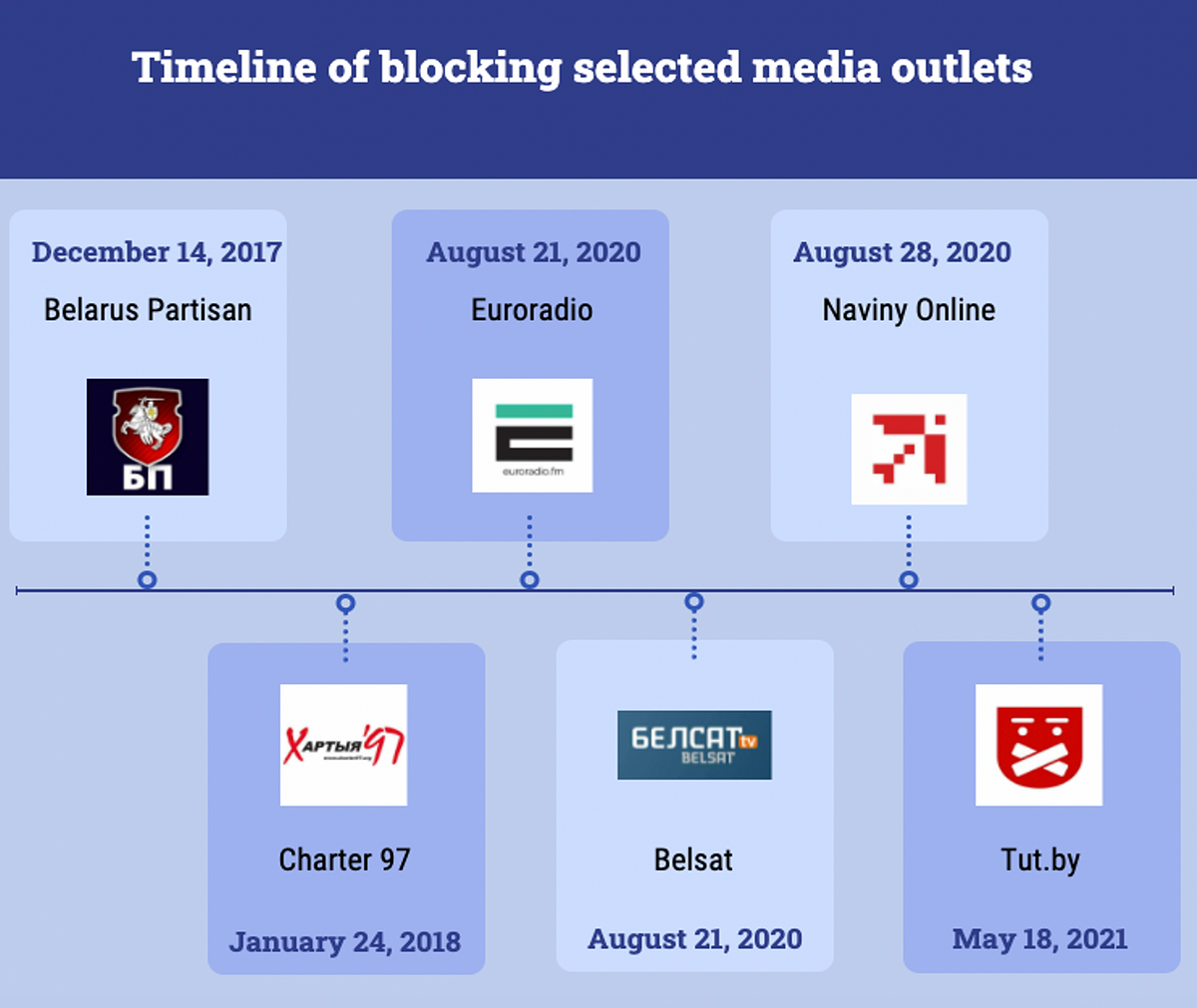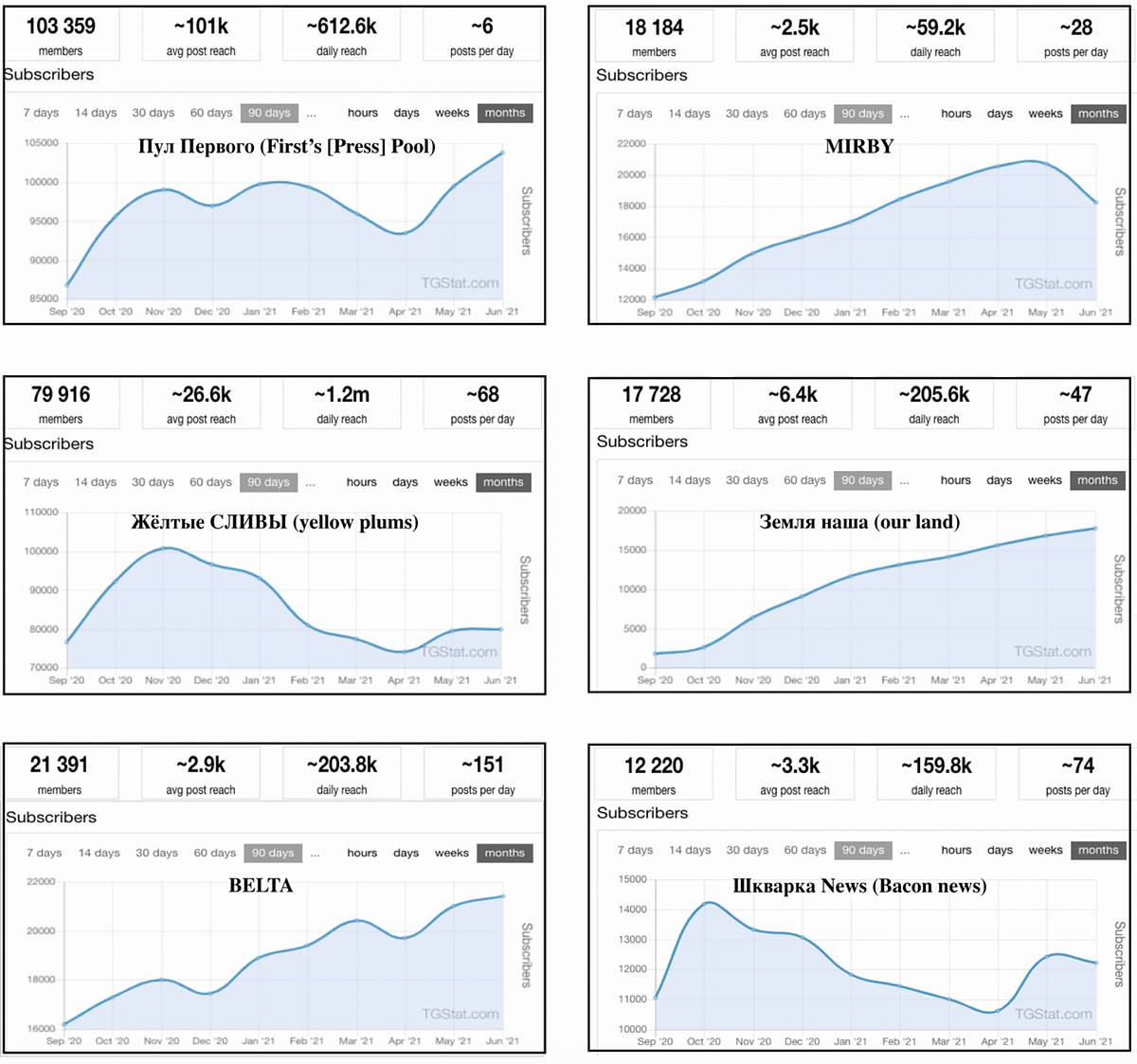Anti-government channels have begun losing ground on Telegram, however

By Givi Gigitashvili
Since being blocked by the Belarusian government and labeled as “extremist,” multiple independent media outlets in the country have experienced a surge in followers on Facebook and maintained their leading positions vis-à-vis pro-government outlets.
Amid protests over the summer of 2020, the Belarusian Ministry of Information blocked 85 online resources on August 21 of that year, including websites of independent media outlets, websites of opposition politicians, various VPN services, and privacy apps. At the time, the Belarusian Association of Journalists stated that in doing so, the Belarusian government intended to disrupt the spread of information on post-election protests and police brutality against demonstrators. The move was seen as a censorship and the obstruction of the legal activities of the media in Belarus. In addition to blocking websites, authorities detained 480 journalists in Belarus in 2020, with 27 journalists still behind bars as of June 2021.
During the August 2020 protests, Telegram channels became an important source of information and a venue for coordination among pro-democracy protesters. The channels’ follower counts grew rapidly. When the Belarusian government disrupted internet access in Belarus, Telegram enabled anti-censorship tools to ensure that the app would remain accessible to the majority of users in the country. This made Telegram an even more reliable and essential tool for Belarusians to receive information about the protests. As these independent channels flourished, however, forces connected to the Belarusian government started to use Telegram more actively to disseminate counter messaging. Soon after, the Belarusian government declared around 30 opposition Telegram channels “extremist material,” and accused them of publishing information inciting riots.
Despite these efforts to suppress the reach of outlets critical of the government, however, these channels’ Facebook pages have largely outperformed the pages of state-controlled outlets in Belarus.
Methodology
In order to analyze the performance of the banned outlets on social media, the DFRLab selected six media outlets with the highest number of followers on Facebook that all had their websites blocked by the Belarusian government in 2020 or earlier: Belarus Partisan, Charter 97, Euroradio, Belsat TV, Naviny, and Tut.by. The majority of these outlets were founded in Belarus, with the exception of Belsat TV, which was founded in Poland but focuses exclusively on Belarus. After these websites were blocked, people in Belarus started to use various tools such as TOR, VPNs, and proxy servers to bypass the ban and access prohibited content.

Along with these independent media outlets, the DFRLab also selected six government-controlled media outlets with the biggest audiences on Facebook: Belarus 24 TV, Belta, Belarus Today, ONT TV, Belarus 1, and ATN Belarus and World News. This case study compares the performance of these two groups.
Facebook analysis
The DFRLab looked at the growth/decline of the audiences of independent media outlets as well as state-controlled outlets during the period spanning June 2020 to June 2021. The combined number of followers of the six independent media outlets stood at around 407,000 in June 2020 and increased to over 566,000 by June 9, 2021, while the total number of followers of the six pro-government outlets increased from 198,000 in June 2020 to 334,000 by June 9, 2021.
Analysis using the Facebook monitoring tool Crowdtangle showed that the independent media outlets gained more new followers than state-controlled outlets over the last year, a period characterized by incessant protests and a brutal crackdown from the Belarusian security services. Moreover, the selected independent outlets began with 52 percent more followers than pro-government outlets in June 2020.

The DFRLab separately analyzed the audiences of the independent outlets after their websites were blocked and found that the majority of them registered a significant increase in followers in the month of the website restrictions. The websites of Euroradio, Belsat TV, and Naviny.by were blocked in August 2020. The same month, these outlets’ Facebook pages registered a jump in follower counts. Along similar lines, the pages of Belarus Partisan and Charter 97 registered a higher rate of audience growth in December 2017 and January 2018, respectively, the months the Belarusian government blocked each channel. Lastly, when Tut.by was banned in May 2021, its Facebook page registered an impressive audience growth rate that month. Thus, the blocking of these websites likely led to a surge in interest in their corresponding Facebook pages, as people continued to seek access to independent and reliable news.
However, it is worth underlining that each selected independent outlet grew its followers base in August 2020, suggesting the large-scale protests following the controversial presidential elections also increased interest in the outlets across the board. It is thus difficult to isolate the effects of the website restrictions on the audience growth of the Facebook pages, beyond saying that the restrictions likely encouraged social media users to seek out the same information by other means.

The DFRLab also found that the average monthly interactions on posts published by the six independent outlets’ pages throughout the observation period was around 300 percent higher than the average interactions on the pro-government outlets’ pages. The former were also more active, posting around 5,000 more posts during this period than pro-government outlets. Additionally, the average monthly interaction rate on content posted by the independent outlets was 67 percent higher. This indicates that users interacted with content published by independent outlets more than with content published by propagandist outlets.

Website traffic analysis
The DFRLab used Sitechecker to compare traffic on websites of the selected independent outlets with the traffic on the state-controlled outlets. The independent websites garnered over 67 million visits from December 2020 to May 2021, while the pro-government websites registered over 98 million visits during the same period. Sitechecker was not able to analyze three websites: the independent outlets Naviny.by and Tut.by and the pro-government Belarus24.by.
In short, independent outlets garnered more interactions on social media but fewer website visits than state-controlled outlets, suggesting that the blocking of the websites did hurt the independent outlets’ web traffic, but not their social media presence.

Telegram analysis
The DFRLab also analyzed the performance of pro-government and pro-opposition Telegram channels and found that pro-opposition channels have a much larger audience. The DFRlab selected six Telegram channels with the largest number of subscribers from the list of outlets designated as “extremist material” by the Belarusian Ministry of Information: Беларусь головного мозга (“Belarus of the brain”); МотолькоПомоги (“Motolko Help”); МАЯ КРАІНА БЕЛАРУСЬ (“My country Belarus”); Черная книга Беларуси (“Belarus Black Book”); BYPOL; and Nexta Live. The Ministry of Information accused the administrators of these channels of encouraging people to participate in unauthorized rallies, as well as encouraging the seizure of power by unconstitutional means.
When a Telegram channel is branded as “extremist,” the adminstrators may be subject to financial penalties and potential criminal liability for posting and reposting content from flagged sources, such as the recent detention of former Nexta Live editor Roman Protasevich. In addition to these channels, the DFRLab also selected six pro-government Telegram channels for further analysis: Земля наша (“Our land”); “Жёлтые СЛИВЫ” (Yellow Plums); Пул Первого (First’s [Press] Pool); MIRBY; Шкварка News (“Bacon News”); and Belta.
According to TG Stats, the six pro-opposition Telegram channels had over 1.8 million followers in total as of June 9, 2021, with an average daily post reach of over 11 million views. On the other hand, the pro-government channels had around 250,000 subscribers and their cumulative daily post reach amounted to around 3 million views. Despite these difference in audience size and daily post reach, the majority of anti-Lukashenko channels have been rapidly losing their subscribers since September 2020, while four out of six pro-government channels have been gaining new subscribers. It is unclear what the reason is for the rapid audience decline of anti-Lukashenko Telegram channels, however, especially as the decline began prior to the channels being branded as “extremist” by the government.


The DFRLab also observed a suspicious audience growth pattern in the case of the Пул Первого (“First’s [Press] Pool”) Telegram channel, which is believed to be managed by President Lukashenka’s press secretary, Natalya Eismont. More specifically, this channel gained over 13,000 subscribers in one day on June 12, 2021. TG Stats data from 2021 shows that the number of daily new subscribers to this channel has never been higher. Moreover, while the channel garnered over 13,000 new subscribers on June 12, views on its posts decreased from over 60,000 on June 11 to around 26,000 on June 12. Thus, it is possible that this Telegram channel is artificially inflating its subscriber base by purchasing new subscribers.

The DFRLab analysis showed that the Belarusian government’s decision to block the websites of independent media outlets coincided with an increase in their Facebook audience, where opposition outlets have much greater reach than pro-government media. However, pro-government media sources registered higher traffic to their websites compared to independent media outlets. Lastly, the popularity of anti-Lukashenko Telegram channels is steadily decreasing, while the majority of pro-government channels have grown their subscriber base over the same period of time.
Givi Gigitashvili is a Research Assistant, Caucasus, with the Digital Forensic Research Lab and is based in Georgia.
Cite this case study:
Givi Gigitashvili, “Belarusian independent media and Telegram channels outperform state media on Facebook,” Digital Forensic Research Lab (DFRLab), June 17, 2021, https://medium.com/dfrlab/belarusian-independent-media-and-telegram-channels-outperform-state-media-on-facebook-45f9397f24c7.
Follow along for more in-depth analysis from our #DigitalSherlocks.

